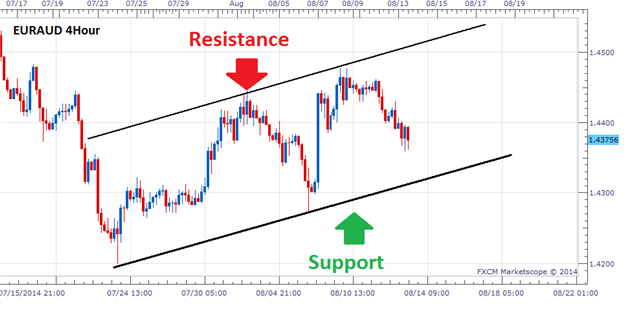Price Channels for Trend Trading
by
, 09-14-2014 at 03:07 AM (1259 Views)
First, before you can trade a price channel, you need to identify on your graph. This process can be done relatively easily using basic technical analysis. Traders should first identify and connect a series of highs and lows on your graph. Below we can see an example of this process on a EURAUD 4Hour chart. Notice how resistance has been formed by connecting the two previous highs to form a ascending line of resistance. Since resistance is rising, this means support should be rising as well as with the creation of a series of higher lows. These lows should run parallel to the resistance line that was previously drawn completing the price channel pattern.
While the EURAUD graph used in today’s example is an ascending price channel, it should be noted that channels may also decline in a downtrend or trade sideways during ranging markets.
Learn Forex – EURCAD 4Hour
Trading the Channel
Once a price channel has been identified, we can then take a plan of action for trading it. Trading pricing channels is much like trading a range since we will pinpoint areas of support and resistance for entry order placement. In an ascending pricing channel entries can be set on or near a level of existing support. Traders will look to buy the market in an uptrend in the event price bounces from support up to a higher high. It’s important to remember that trading a pricing channel is ultimately a support and resistance strategy. That means that traders will wait for their opportunity to enter the market and not trade when prices reside between these levels.
One of the easiest ways to trade and ascending price channel is to set a buy entry at support. This way when price touches this value, orders to buy the EURAUD would be executed into the market. However, traders seeking further market confirmation can also employ the use of an oscillator such as CCI when trading pricing channels. Traders using an oscillator will wait for their indicator of choice to return from overbought territory to sell as market momentum begins to return lower in a declining channel.
Trading with oscillators may be new for some traders. For more information on CCI be sure to take advantage of DailyFX’s training course through Brainshark. The course is free and after clicking the link below sign into our ‘Guestbook’. You will be met with a series of videos including other strategies involving the CCI Indicator!
Learn Forex – USDCHF Channel Entries
Exiting Positions
Once an entry is decided, the next step in trading channels is to plan your exit. One reason traders like price channels, is because they provide clear areas for stop and limit order placement. In an upward sloping channel, stops should always be placed below the line of support. If price moves to a lower low and invalidates the channel, traders will want to exit positions to buy the EURAUD as quickly as possible.
Profit targets can also be set by using the pricing channel pictured above. Areas to take profit can be extrapolated by extending our line of price resistance. Traders will want to exit on a test of this line, as price may reverse at this point and continue trading inside of the channel.
---Written by Walker England, Trading Instructor
More...














 Email Blog Entry
Email Blog Entry